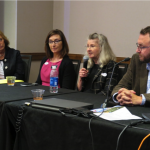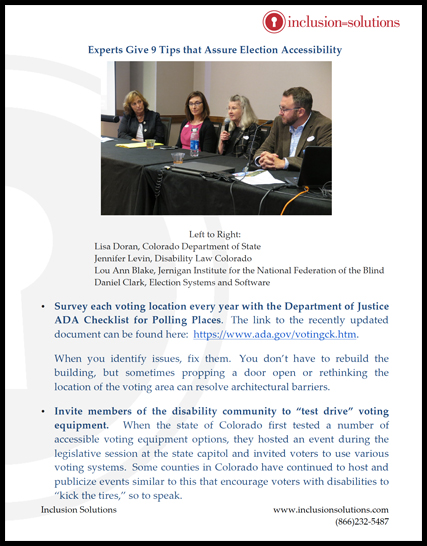
This summer, Inclusion Solutions had the pleasure of speaking at the National ADA Symposium in Denver on elections accessibility. Following this presentation, numerous attendees requested practical tips for achieving elections accessibility, and when you ask, we deliver! Here are nine practical tips for achieving elections accessibility, courtesy of experts Lisa Doran (Colorado Department of State), Jennifer Levin (Disability Law Colorado), Lou Ann Blake (Jernigan Institute for the National Federation of the Blind), and Daniel Clark (Election Systems and Software).
Survey each voting location every year with the Department of Justice ADA Checklist for Polling Places. The link to the recently updated document can be found here: https://www.ada.gov/votingck.htm. And when you identify issues, fix them! You don’t have to rebuild the building, but sometimes propping a door open or rethinking the location of the voting area can resolve architectural barriers.
Invite members of the disability community to “test drive” voting equipment. When the state of Colorado first tested a number of accessible voting equipment options, they hosted an event during the legislative session at the state capitol and invited voters to use various voting systems. Some counties in Colorado have continued to host and publicize events similar to this that encourage voters with disabilities to “kick the tires,” so to speak.
If you are uncertain how to contact these communities, meet with your Protection and Advocacy representatives for the city and/or state in which you live. If the representatives don’t feel they have the expertise to evaluate the system, they may help you contact members of the disability community who would be willing to “test drive” the equipment. These representatives can also help you brainstorm resolutions to any issues you uncover when conducting these elections accessibility surveys. This has a twofold benefit in that you not only ensure your voting systems are reasonably accessible, but you also develop a proactive working relationship with the P&A community (rather than a reactive relationship focusing on complaint resolution).
Conduct disability etiquette training. Provide training for your election judges and other polling place staff on how to interact with people with disabilities. People with disabilities are very good at navigating their world. When they do need assistance, knowing the appropriate way to render that assistance goes a long way to making their voting experience successful. There are a number of free resources online for interacting with people with disabilities. The following link is a resource you can print and use: http://ada.osu.edu/designguidance/disability%20ettiquite.pdf
Don’t be afraid to ask questions. You certainly aren’t expected to know all of the answers, but you are expected to make voting accessible. There are many free resources available for guidance, including the Regional ADA Centers. The ADA Centers can answer questions and help troubleshoot physical barriers: http://www.adapacific.org/resources/resources_ADACenters.php. Your peers in other states can also be a great experiential resource; so don’t hesitate to reach out. And don’t forget the worldwide web! Some experts have met with great success just “googling” issues as well.
Train poll workers on how to set up and operate the accessible voting system using an actual machine, not PowerPoint. Give each poll worker the opportunity to mark a ballot using the machine.
Assign a poll worker for each polling place to be responsible for the accessible machine. He/she will ensure the accessible machine is set up and operating, and will troubleshoot any problems that arise.
Actively engage the disability community. Attend NFB local chapter meetings and affiliate conventions to talk about the accessible voting system, give members the opportunity to practice vote, and recruit poll workers. (Local chapters can be found at https://nfb.org/state-and-local-organizations.) Have voters with disabilities participate in poll worker training so poll workers can get a better appreciation for why it is important to have the accessible voting system set up and operating when the polls open.
For vote by mail states and states that do not provide an accessible way to vote absentee: provide an accessible electronic ballot delivery system so print disabled voters can mark their ballots privately and independently – the same as voters without print disabilities.
Give voters options. Some voters with disabilities like the convenience of absentee voting, especially if they have issues such as transportation, while other voters prefer to vote on Election Day in their local precinct “like everyone else.” And still others choose to vote curbside. Don’t assume “one solution fits all” for your community!
Need a hard copy? Download the pdf here!
